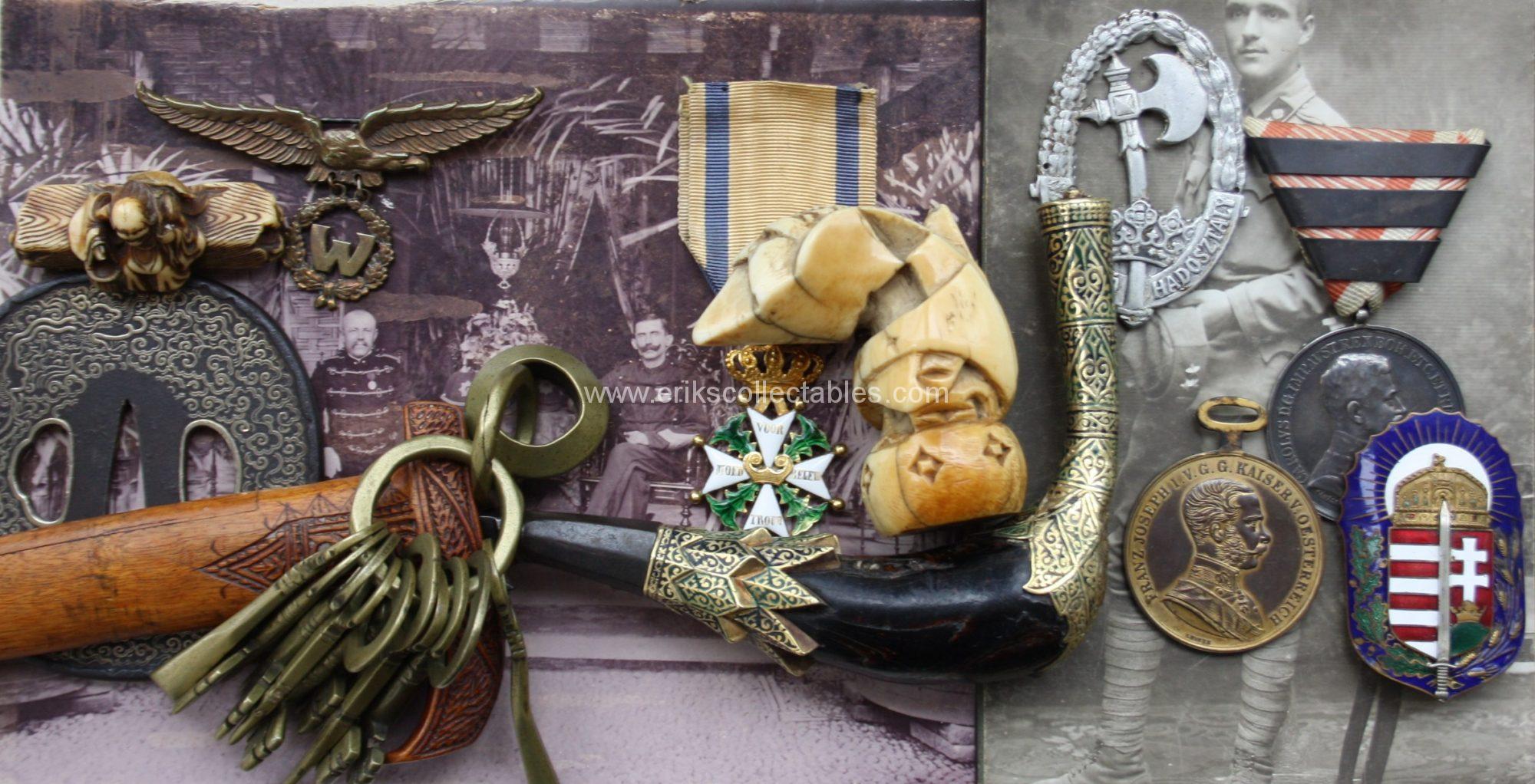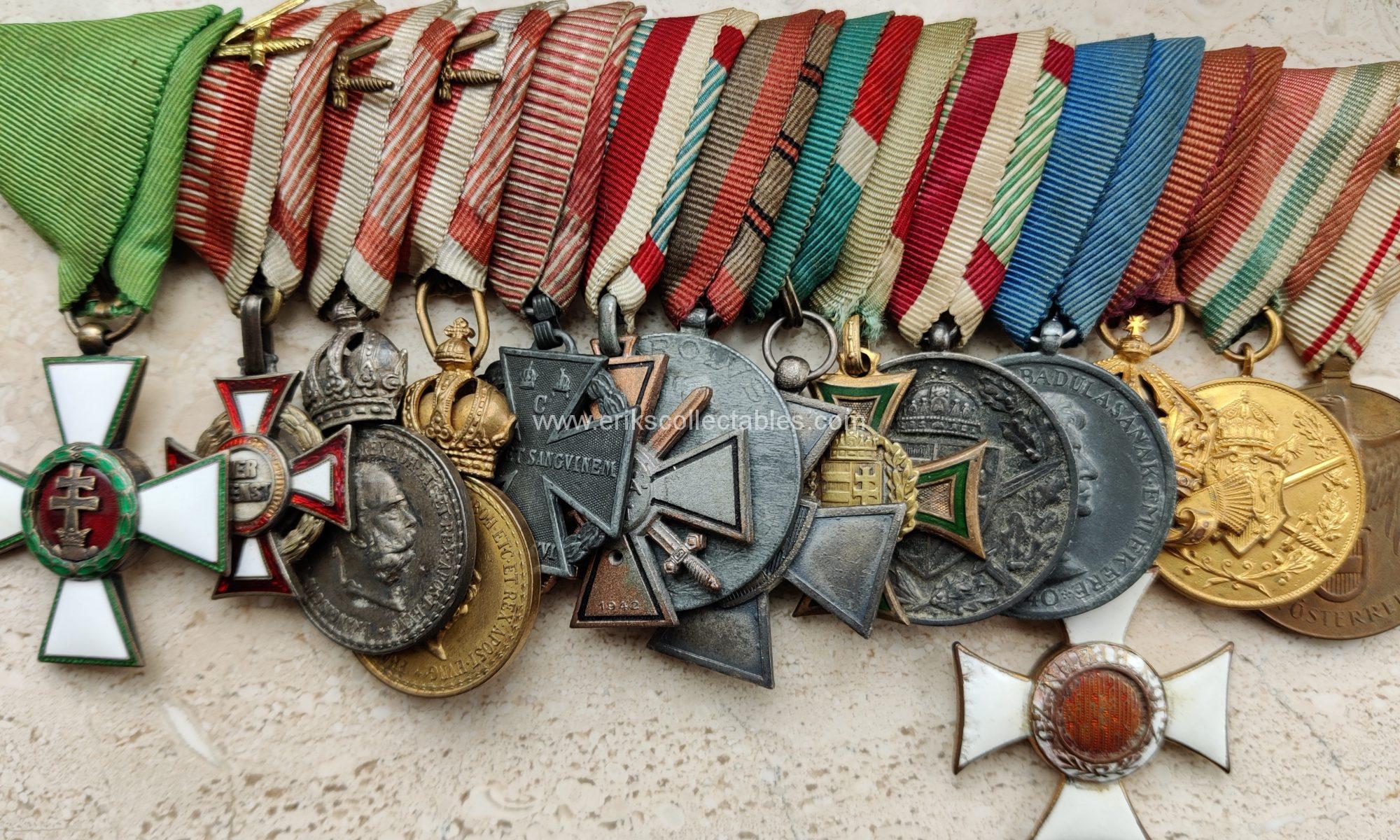This is a compilation of several blogs that I had on another website.
Some time ago I was able to acquire a medal group with papers (not complete but most was there) of a Hungarian officer who saw service in both world wars and the interbellum.
Although the materials came directly from the family there was no additional information so this was the start of my research in which I tried to reconstruct his career based on his medals and archive materials.

In the period just before WW1 Miklosy trained to become an officer (the so called one year volunteers) and he was commisioned as Lieutenant in the reserve in 1914, just in time for the Great War. The photo below shows him as sergeant during his training period to become an officer so probably 1913 or 1914.

For service in World War 1 as an officer he received:
Merit Cross 3rd class, Silver Merit Medal, Bronze Merit Medal, Wounded Medal with three stripes on the ribbon, Karl Troop Cross and the remembrance medals of Hungary, Austria and Bulgaria. Basically the set of a lower ranking officer with good (brave) performance. Only of one of these medals the story could be reconstructed based on the Medal Request Form that was found in the Hungarian Military Archives
Silver Military Merit Medal
This is the Silver Military Merit Medal with swords in its original box and with the 1917 award paper to the (then) Lieutenant Nikolajevics in the 301st Honved Infantry Regiment – his name would be changed to Miklosy only in 1932.

In the morning hours of the 5th of March, 1917 when superior enemy units attacked our positions on the Vinot heights, he distinguished himself with death-defying behavior and with energetic actions of the machineguns by, at the right moment giving strong fire against the flanks of the enemy attack causing strong losses, in which he contributed strongly in the repelling of the attack. He continued with his men, throughout the day, in killing enemy artillery fire that destroyed our positions almost entirely, to stand his ground.
The 301st Honved Infantry Regiment was in 1917 part of the Austro-Hungarian 7th Army that fought in the Russo-Romanian front in these beginning days of the Russian revolution that would change the war.

Interwar Period
In the interwar period he continued his service with succes based on his medals in that period, a bronze merit medal and a merit cross and continuing his rise through the officers ranks reaching the rank of lieutenant-colonel at the beginning of the re-annexations of lost territories. One medal is peculiar.
Bulgarian St. Alexander Order, 4th class
Although this medal came with the official document it would have been impossible to determine the reason behind it if not another piece of paper had accompanied it. The official report of the Hungarian military participation in the opening in 1935 of a Mausoleum in Varna, Bulgaria.
The Mausoleum was made in honour of the Polish / Hungarian / Croatian King Vladyslaw III. The Mausoleum was placed in Varna, the city in Bulgaria where history places his untimely death at the age of 20 in a battle against the Turks in 1444.
A group of 4 Hungarian officers participated as the Hungarian delegation in this opening of which Miklosy was one. All participants received Bulgarian orders for their participation in the opening according to rank.

Vitéz order – change of names in 1935
One of the requirements for the Hungarian Vitéz order was having a Hungarian name. For Hungarians of other descent like German or Slavic this was a big obstacle. Many officers with a non-Hungarian name decided not to apply for the Vitéz order or only very late like this officer only in 1932 (the order was started in in 1922). Probably he did this to improve his chances to further advance his career. His name was changed from Nikolajevics into Miklósy as a result!

Zrínyi Miklós 7th Honvéd Infantry Regiment (gyalogezred)
From 1939 up to 1941 Miklosy served as Lt-Colonel in the 7th Honved Infantry Regiment. This regiment is named after the Hungarian poet and military leader Zrínyi Miklós. Upon his transfer to the 9th Regiment he received a formal commendation for his work in the unit which was accompanied by this very nice table medal in it’s original presentation box.

Return of Erdély and Felvidék to Hungary
Both, the ranklist and the officers record (that is kept in the military archives) regarding Miklosy state that he received the Erdély (Transylvania) medal. This is shown with the sign of an encircled E. The medal was in the estate too but to my own surprise there was this paper that states he received a commendation for merit (on paper, not a medal) for the action in Felvidék (Southern Hungary) but he has not been awarded the corresponding medal for actual participation in that action in Felvidék.
So a separate commendation for merit regarding that action but no medal for the participation – did he do staff prepatory work? It will be impossible to tell what is the story here I am afraid.

Commander of the 32nd HIR – Eastern Front 1942-43
In the second world war Hungary was an unwilling, but nevertheless active, part of the Axis forces. Their participation on the Eastern Front with a hardly trained and poorly equipped army resulted in an enormous bloodshed. Miklosy was a part of this as the commander of the 32nd Honved Infantry Regiment from October 1942 up to October 1943.

In 1942 he got promoted to Colonel – in Hungarian Ezredes – literally 1000, so the leader of 1000 men. In Hungarian the word for Regiment is Ezred – so 1000 men. So it follows a colonel belongs to a regiment.
Because of the war effort many Regiments were split. In this case the 2nd Honved Infantry Regiment was split in two with both officers and men and then officers and men were added to both units. So the half of a trained regiment with backfill of additional officers and troops. The so-called brother regiment would have the same number +30 so in the case the 2nd and the 32nd were brother regiments.
Miklosy with his promotion to Colonel became eligible for the position of Regimental Commander and received the 32nd as his new unit to command in oktober 1942.
From that period up to 1943 they were on the Eastern Front as part of the Hungarian 2nd Army near the Don bend, south of Voronezh. Miklósy was a replacement after the initial battles that cost more than 20% of the officers lives. They served next to the Italian 8th Army. In January 1943 they would face the Russian attack in their region and the total collapse of the Hungarian 2nd army resulting in 60% casualties of the total strength.
Colonel Miklosy would “only” receive the Iron Class 2nd class from his German allies. A relatively low award for a colonel with one year of service on the Eastern Front. Maybe he was not as co operative as they expected or not as active? What is certain his regiment was part of the 2nd Hungarian army that suffered great losses against the Russian forces during his command of the 32nd regiment and the Germans in general blaimed the Hungarians for the defeat near the Don.

From the Hungarians he would receive the Officers cross for the Order of Merit , with wreath and swords, a level up from his earlier peace time award so his service there was seen as positive. A rare order with only 215 awarded during the entire war (to Hungarians and around 67 to others, mainly Germans). A substantial amount, around 78 of the total were posthumously which is not strange if you look at the amount of casualties on the Eastern Front. Unfortunately the related documents for this medal are missing.

His career after the Eastern Front seemed shortlived. Upon his return to Hungary he got involved in the Hungarian youth movement, the Levente but his new commander saw him as unfit for further commands and promotions so he had to retire. This might have to do with the change in politics in Hungary in 1944 but the exact circumstances are unclear. Later testomonies do make it clear he did not cooperate with the Arrow Cross leadership so a political retirement does seem realistic.
With the 23rd (reserve) division 1944-45, defense of Hungary
Despite the political (?) differences he was recalled to service in August 1944 and served in the 23rd Honvéd (reserve) Division (hadosztály) in defense of Hungary against the Russian forces that were coming close to the borders. He even became the divisions last commander of the war. The unit defended Hungary and ended up in the Czech republic, surrendering there to the Russians in May 1945 near the city of Bechin with the remaining 2500 men of the division…
More research into this last part of his military career is needed. In post war testimonies (more than 10) it is made clear he viewed it his task to defend Hungary against the Russians but did not cooperate with the Germans more than was needed for this. There is a statement made regarding Labatlán in Hungary that also needs further research.



He spent the next 3 years in Russian POW camps before returning to Hungary in 1948. From that period muliple testimonies exist, as stated above, from other military men that served with him stating that he was not a fascist/ friend of the Germans. He continued to live in Szeged untill his death in 1968.
Although there are many more documents in the group than shown here most of the documents spanning the later part of the war were lost.
Award document signed by Miklósy (as commander of the 32nd HIR 1943)
Years afther the Miklósy group came into my custody I was able to trade this group that links to Miklósy. It is a bronze bravery medal and firecross both with papers to the same soldier. The bravery medal was given out by the Eastern Hungarian Occupation Forces but the firecross was awarded by the 32nd Honvéd Infantry Regiment and is actually signed by Miklósy as commander of the unit! It is hard to read but it says vMiklósy Ezds (vitéz Miklósy Ezredes) and for reference I have a post war signature of him as reference. The same signature but without the titles. A great addition to the Miklósy group, an award document signed by him in his role as the commanding officer of the 32nd HIR during his year on the Don. Synchronicity at its best!



The set of Miklósy was inherited by a relative and I was able to buy it in two groups. Not everything had been sorted out when I bought the first batch but obviously the rest of the material was also offered to me. Unfortunately the set was not complete, especially from WW2 materials were missing. What happened to these over time is impossible to tell but if something related to him is for sale do let me know!

*Reference: Babucs Zoltán – Szabó Péter: “Legyetek eskütökhöz hívek mindhalálig…” A budapesti magyar királyi “József nádor” 2. honvéd gyalogezred a második világháborúban (Puedlo, Budapest-Nagykovácsi, 2013.)
I do not have the book yet but the photo from internet originally came from this source I have learned.

